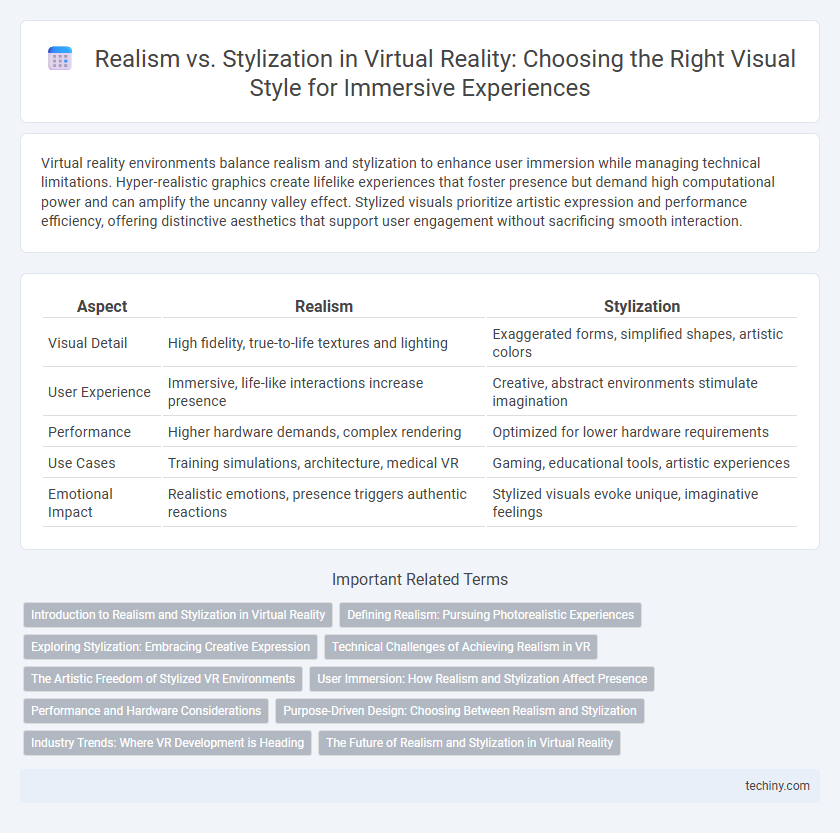Virtual reality environments balance realism and stylization to enhance user immersion while managing technical limitations. Hyper-realistic graphics create lifelike experiences that foster presence but demand high computational power and can amplify the uncanny valley effect. Stylized visuals prioritize artistic expression and performance efficiency, offering distinctive aesthetics that support user engagement without sacrificing smooth interaction.
Table of Comparison
| Aspect | Realism | Stylization |
|---|---|---|
| Visual Detail | High fidelity, true-to-life textures and lighting | Exaggerated forms, simplified shapes, artistic colors |
| User Experience | Immersive, life-like interactions increase presence | Creative, abstract environments stimulate imagination |
| Performance | Higher hardware demands, complex rendering | Optimized for lower hardware requirements |
| Use Cases | Training simulations, architecture, medical VR | Gaming, educational tools, artistic experiences |
| Emotional Impact | Realistic emotions, presence triggers authentic reactions | Stylized visuals evoke unique, imaginative feelings |
Introduction to Realism and Stylization in Virtual Reality
Realism in virtual reality aims to replicate real-world environments and interactions with precise detail, enhancing user immersion through accurate textures, lighting, and physics. Stylization, in contrast, employs artistic techniques and exaggerated features to create distinct visual experiences that prioritize mood and creativity over exact replication. Balancing realism and stylization influences user perception, engagement, and the overall effectiveness of VR applications in gaming, training, and storytelling.
Defining Realism: Pursuing Photorealistic Experiences
Realism in virtual reality emphasizes the creation of photorealistic experiences by accurately simulating textures, lighting, and spatial audio to mirror the physical world. Achieving high fidelity graphics and precise motion tracking enhances immersion and user presence, making virtual environments indistinguishable from reality. Photorealistic VR applications rely on advanced rendering techniques such as ray tracing and high-resolution models to replicate real-world visuals authentically.
Exploring Stylization: Embracing Creative Expression
Stylization in virtual reality enables developers to craft immersive experiences that prioritize artistic expression over photorealism, enhancing emotional resonance and user engagement. By utilizing exaggerated visuals, vibrant color schemes, and abstract environments, VR creators invite users to explore imaginative worlds that transcend real-world constraints. This approach fosters unique storytelling possibilities and personalized experiences, making stylized VR a powerful tool for creative innovation.
Technical Challenges of Achieving Realism in VR
Achieving realism in VR demands overcoming technical challenges such as latency reduction, high-resolution rendering, and precise motion tracking to maintain immersion and prevent motion sickness. Realistic lighting, texture detail, and physics simulation require substantial computational power and optimized hardware to deliver a convincing experience. Balancing these factors while ensuring smooth performance is crucial to avoid breaking the sense of presence in virtual environments.
The Artistic Freedom of Stylized VR Environments
Stylized VR environments harness artistic freedom by allowing creators to design worlds unconstrained by physical realism, enhancing emotional engagement and narrative depth. This approach facilitates unique visual aesthetics that prioritize user experience over accurate replication, often resulting in more memorable and immersive interactions. By emphasizing creative expression, stylized VR can evoke distinct atmospheres and moods tailored to specific storytelling or gameplay objectives.
User Immersion: How Realism and Stylization Affect Presence
Realism in virtual reality enhances user immersion by replicating lifelike environments and textures, which strengthens the sense of presence and spatial awareness. Stylization leverages artistic abstraction to evoke emotional responses and maintain engagement without overwhelming users with excessive detail. Balancing these approaches optimizes user experience by aligning visual fidelity with narrative goals and hardware capabilities.
Performance and Hardware Considerations
In Virtual Reality, balancing realism and stylization is crucial for optimizing performance and hardware capabilities. High-fidelity graphics demand significant GPU and CPU resources, potentially causing latency and reducing frame rates, which can lead to motion sickness. Employing stylized visuals decreases computational load, enabling smoother experiences on less powerful hardware while maintaining immersive engagement.
Purpose-Driven Design: Choosing Between Realism and Stylization
Purpose-driven design in virtual reality prioritizes either realism or stylization based on user experience goals and technical constraints. Realism enhances immersion through lifelike environments and accurate physics, ideal for training simulations and therapeutic applications. Stylization leverages artistic abstraction to evoke emotions and creativity, making it effective for entertainment and educational narratives.
Industry Trends: Where VR Development is Heading
VR development is increasingly balancing realism and stylization to enhance user immersion and accessibility, with industry trends showing a shift towards hyper-realistic environments powered by advanced graphics engines like Unreal Engine 5. Stylized VR experiences remain popular in sectors like education and therapy due to their ability to simplify complex concepts and reduce cognitive load. Future VR platforms are expected to integrate AI-driven adaptive visuals that dynamically adjust realism levels based on user preferences and application contexts.
The Future of Realism and Stylization in Virtual Reality
Advancements in GPU technology and ray tracing algorithms drive the future of realism in virtual reality, enabling lifelike textures, dynamic lighting, and immersive environments. Stylization remains pivotal for experiences prioritizing performance efficiency and artistic expression, with procedural generation and neural rendering techniques enhancing visual diversity and creativity. Emerging trends suggest a hybrid approach where AI-powered adaptive rendering dynamically balances photorealism and stylization based on user interaction and hardware capabilities.
Realism vs Stylization Infographic

 techiny.com
techiny.com